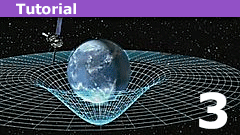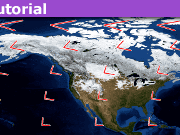Exploring Fermi-Walker Transport in Kerr Spacetime
In the last two posts in this series, we developed some tools for looking at Fermi-Walker transport in Minkowski spacetime and then applied them in Schwarzschild spacetime. In this post, we’ll look at Kerr spacetime, which will introduce some additional complexities.
The first congruence we will look at in Kerr spacetime is the hovering congruence, which is the analog of the static/hovering congruence in Schwarzschild spacetime. As we did in Schwarzschild spacetime, we are restricting attention to the equatorial plane, ##\theta = \pi / 2##, and we will label the axial coordinate by ##z## and ignore the ##dz## component in the metric, as before. The line element is:
$$
ds^2 = – \left( 1 – \frac{2M}{r} \right) dt^2 – \frac{4 M a}{r} dt d\phi + \frac{1}{1 – \frac{2M}{r} + \frac{a^2}{r^2}} dr^2 + \left[ 1 + \frac{a^2}{r^2} \left( 1 + \frac{2M}{r} \right) \right] r^2 d\phi^2
$$
For convenience, we define the following:
$$
B = \frac{2 M a}{r^2}
$$
$$
V^2 = \left( 1 – \frac{2M}{r} \right) = \left( 1 – \frac{B r}{a} \right)
$$
$$
H^2 = \left[ 1 + \frac{a^2}{r^2} \left( 1 + \frac{2M}{r} \right) \right]
$$
$$
W^2 = 1 – \frac{2M}{r} + \frac{a^2}{r^2} = V^2 + \frac{a^2}{r^2} = V^2 H^2 + B^2
$$
so that the metric becomes:
$$
ds^2 = – V^2 dt^2 – 2 B r dt d\phi + \frac{1}{W^2} dr^2 + H^2 r^2 d\phi^2
$$
We will also need the inverse metric coefficients; for the ##t – \phi## portion (the other portion is diagonal so the inverses are trivial), these are obtained by inverting the 2 x 2 matrix formed by that portion of the metric, which gives
$$
g^{tt} = – \frac{H^2}{W^2}
$$
$$
g^{t \phi} = g^{\phi t} = – \frac{B}{r W^2}
$$
$$
g^{\phi \phi} = \frac{V^2}{r^2 W^2}
$$
The hovering congruence frame field is:
$$
\hat{h}_0 = \frac{1}{V} \partial_t
$$
$$
\hat{h}_1 = \partial_z
$$
$$
\hat{h}_2 = W \partial_r
$$
$$
\hat{h}_3 = – \frac{B}{V W} \partial_t + \frac{V}{r W} \partial_{\phi}
$$
Here we see the first added complexity: there is an extra term in ##\hat{h}_3##. This arises from the ##dt d\phi## “cross term” in the metric. Or, to put it in more physical terms, it arises because the surfaces of constant ##t## are not orthogonal to the vector field ##\partial_t##; the direction in spacetime that is orthogonal to ##\partial_t## in the ##\phi## direction actually points somewhat in the ##- \partial_t## direction. That cross term also adds more index possibilities when we evaluate covariant derivatives along the 4-velocity.
The covariant derivatives along the 4-velocity are:
$$
\nabla_{\hat{h}_0} \hat{h}_0 = – \frac{1}{2} g^{rr} \left( \partial_r g_{tt} \right) u^t u^t \partial_r
$$
$$
= – W^2 \left( – \frac{M}{r^2} \frac{1}{V^2} \right) \partial_r
$$
$$
\nabla_{\hat{h}_0} \hat{h}_1 = 0
$$
$$
\nabla_{\hat{h}_0} \hat{h}_2 = \frac{1}{2} u^t r^r \left[ \left( g^{tt} \partial_r g_{tt} + g^{t\phi} \partial_r g_{t\phi} \right) \partial_t + \left( g^{\phi t} \partial_r g_{tt} + g^{\phi \phi} \partial_r g_{t\phi} \right) \partial_{\phi} \right]
$$
$$
= \frac{W}{V} \left[ \left( \frac{H^2}{W^2} \frac{M}{r^2} – \frac{B}{r W^2} \frac{M a}{r^2} \right) \partial_t + \left( \frac{B}{r W^2} \frac{M}{r^2} + \frac{V^2}{r^2 W^2} \frac{M a}{r^2} \right) \partial_{\phi} \right]
$$
$$
\nabla_{\hat{h}_0} \hat{h}_3 = – \frac{1}{2} g^{rr} \left[ \left( \partial_r g_{tt} \right) e^t + \left( \partial_r g_{t \phi} \right) e^{\phi} \right] u^t \partial_r
$$
$$
= – W^2 \left( \frac{M}{r^2} \frac{B}{V W} + \frac{M a}{r^2} \frac{V}{r W} \right) \frac{1}{V} \partial_r
$$
After some wrangling, we obtain the same familiar form as before:
$$
\nabla_{\hat{h}_0} \hat{h}_0 = A \hat{h}_2
$$
$$
\nabla_{\hat{h}_0} \hat{h}_2 = A \hat{h}_0 + \Omega \hat{h}_3
$$
$$
\nabla_{\hat{h}_0} \hat{h}_3 = – \Omega \hat{h}_2
$$
where
$$
A = \frac{M W}{r^2 V^2}
$$
$$
\Omega = \frac{M a}{r^3 V^2}
$$
We can now see the second complexity: there is a twist (pun intended) in the above. This congruence has nonzero vorticity even though it is not rotating with respect to a distant observer. The vorticity is positive, so this frame field’s vectors spin about the ##z## axis, relative to gyroscopically stabilized vectors, in the same sense as the rotation of the black hole. But this frame field’s vectors are fixed relative to a distant observer, so the Fermi-Walker transported vectors are rotating, relative to infinity, in the opposite sense to the hole.
This phenomenon is sometimes termed “frame-dragging” (although that term can be used to denote several different, though related, things), and MTW draws an analogy with vortices induced in a viscous fluid by a rotating ball. In the equatorial plane of the ball’s rotation, the fluid vortices rotate in the opposite direction to the ball (much as smaller gears engaged with a larger gear rotate in the opposite direction to the larger gear).
We will now consider the rotating congruence, and since there are more complexities involved in figuring out its frame field in this case, we will go into more detail about how it is derived. Our starting point is the fact that the angular velocity ##\omega## of the congruence is defined as ##d \phi / dt##, which is also the ratio ##u^\phi / u^t##, where ##u## is the 4-velocity (i.e., the timelike vector of our frame field). So we must have ##\hat{p}_0 = (1 / D) \partial_t + (\omega / D) \partial_\phi##, where ##D## at this point is an undetermined constant, but we can see that it is related to the “time dilation factor” of an observer following a worldline of the congruence, relative to an observer at rest at infinity.
To find the value of ##D##, we simply evaluate the squared norm of ##\hat{p}_0## using the metric, knowing that its value must be ##-1##:
$$
-1 = – \frac{V^2}{D^2} – \frac{2 B r \omega}{D^2} + \frac{H^2 r^2 \omega^2}{D^2}
$$
This obviously gives
$$
D^2 = V^2 + 2 \omega r B – \omega^2 r^2 H^2
$$
We can obtain a formula for ##\gamma##, the relativistic gamma factor between the rotating observer and a hovering observer, by computing the inner product of ##\hat{p}_0## and ##\hat{h}_0##, which will be ##- \gamma## (the minus sign is because of the metric signature convention we are using):
$$
\gamma = V^2 \frac{1}{D} \frac{1}{V} + B r \frac{\omega}{D} \frac{1}{V} = \frac{V^2 + \omega r B}{V D}
$$
We can compute a formula for ##v## from this, but we can also derive it by computing ##\gamma v##, which will be the inner product of ##\hat{p}_0## and ##\hat{h}_3##:
$$
\gamma v = – V^2 \frac{1}{D} \left(- \frac{B}{V W} \right) – B r \frac{1}{D} \frac{V}{r W} – B r \frac{\omega}{D} \left(- \frac{B}{V W} \right) + H^2 r^2 \frac{\omega}{D} \frac{V}{r W} = \frac{\omega r W}{V D}
$$
This gives
$$
v = \frac{\omega r W}{V^2 + \omega r B}
$$
It is straightforward to check that ##\gamma = 1 / \sqrt{1 – v^2}##, as expected. Also, it will be useful to compute the inverse of this formula since for this case it is not obvious by inspection:
$$
\omega = \frac{v V^2}{r \left( W – v B \right)}
$$
We could now find ##\hat{p}_3## by making use of the fact that it must be orthogonal to ##\hat{p}_0##, and must also be a unit spacelike vector with squared norm ##1##. However, it is easier to simply compute ##\hat{p}_3 = \gamma v \hat{h}_0 + \gamma \hat{h}_3##, which gives:
$$
\hat{p}_3 = \left( \frac{\omega r W}{V D} \frac{1}{V} – \frac{V^2 + \omega r B}{V D} \frac{B}{V W} \right) \partial_t + \frac{V^2 + \omega r B}{V D} \frac{V}{rW} \partial_\phi
$$
Again, it is straightforward to check that ##\hat{p}_3## is orthogonal to ##\hat{p}_0##, as required.
With all this, the frame field we end up with is:
$$
\hat{p}_0 = \frac{1}{D} \partial_t + \frac{\omega}{D} \partial_\phi = \gamma \hat{h}_0 + \gamma v \hat{h}_3
$$
$$
\hat{p}_1 = \partial_z
$$
$$
\hat{p}_2 = W \partial_r
$$
$$
\hat{p}_3 = \frac{\omega r H^2 – B}{W D} \partial_t + \frac{V^2 + \omega r B}{r W D} \partial_\phi = \gamma v \hat{h}_0 + \gamma \hat{h}_3
$$
There are now even more terms to be evaluated for the covariant derivatives:
$$
\nabla_{\hat{p}_0} \hat{p}_0 = – \frac{1}{2} g^{rr} \left[ \left( \partial_r g_{tt} \right) u^t u^t + 2 \left( \partial_r g_{t \phi} \right) u^t u^\phi + \left( \partial r g_{\phi \phi} \right) u^\phi u^\phi \right] \partial_r
$$
$$
= – \frac{1}{2} W^2 \left[ \left( – \frac{2M}{r^2} \right) \frac{1}{D^2} + 2 B \frac{\omega}{D^2} + \left( 2 r – \frac{2 M a^2}{r^2} \right) \frac{\omega^2}{D^2} \right] \partial_r
$$
$$
\nabla_{\hat{p}_0} \hat{p}_1 = 0
$$
$$
\begin{align}
\nabla_{\hat{p}_0} \hat{p}_2 = \frac{1}{2} r^r \left( u^t \left[ \left( g^{tt} \partial_r g_{tt} + g^{t\phi} \partial_r g_{t\phi} \right) \partial_t + \left( g^{\phi t} \partial_r g_{tt} + g^{\phi \phi} \partial_r g_{t \phi} \right) \partial_{\phi} \right] \nonumber \\
+ u^\phi \left[ \left( g^{tt} \partial_r g_{\phi t} + g^{t \phi} \partial_r g_{\phi \phi} \right) \partial_t + \left( g^{\phi t} \partial_r g_{\phi t} + g^{\phi \phi} \partial_r g_{\phi \phi} \right) \partial_{\phi} \right] \right) \nonumber
\end{align}
$$
$$
\begin{align}
= \frac{1}{2} W \left( \frac{1}{D} \left[ \left( \frac{2M}{r^2} \frac{H^2}{W^2} – \frac{B}{r W^2} B \right) \partial_t + \left( \frac{2M}{r^2} \frac{B}{r W^2} + \frac{V^2}{r^2 W^2} B \right) \partial_{\phi} \right] \nonumber \\
+ \frac{\omega}{D} \left[ \left( – \frac{H^2}{W^2} B – \frac{B}{r W^2} \left( 2 r – \frac{2 M a^2}{r^2} \right) \right) \partial_t + \left( – \frac{B}{r W^2} B + \frac{V^2}{r^2 W^2} \left( 2 r – \frac{2 M a^2}{r^2} \right) \right) \partial_{\phi} \right] \right) \nonumber
\end{align}
$$
$$
\nabla_{\hat{p}_0} \hat{p}_3 = – \frac{1}{2} g^{rr} \left[ \left( \partial_r g_{tt} \right) u^t e^t + \left( \partial_r g_{t \phi} \right) \left( u^t e^\phi + u^\phi e^t \right) + \left( \partial_r g_{\phi \phi} \right) u^\phi e^\phi \right] \partial_r
$$
$$
= – \frac{1}{2} W^2 \left[ \left( – \frac{2M}{r^2} \right) \frac{1}{D} \frac{\omega r H^2 – B}{W D} + B \left( \frac{1}{D} \frac{V^2 + \omega r B}{r W D} + \frac{\omega}{D} \frac{\omega r H^2 – B}{W D} \right) + \left( 2 r – \frac{2 M a^2}{r^2} \right) \frac{\omega}{D} \frac{V^2 + \omega r B}{r W D} \right] \partial_r
$$
Once more we can wrangle these into the same familiar form as before:
$$
\nabla_{\hat{p}_0} \hat{p}_0 = A \hat{p}_2
$$
$$
\nabla_{\hat{p}_0} \hat{p}_2 = A \hat{p}_0 + \Omega \hat{p}_3
$$
$$
\nabla_{\hat{p}_0} \hat{p}_3 = – \Omega \hat{p}_2
$$
where
$$
A = \frac{W}{D^2} \left[ \frac{M}{r^2} \left( 1 – a \omega \right)^2 – \omega^2 r \right]
$$
$$
\Omega = \frac{1}{D^2} \omega \left[ 1 – \frac{3M}{r} \left( 1 – a \omega \right) \right] + \frac{M a}{r^3 D^2} \left( 1 – a \omega \right)^2
$$
Here, again, we have some extra effects as compared with the previous case:
(1) It is easier (i.e., requires a smaller orbital velocity) to achieve a free-fall orbit in the prograde direction (i.e., positive ##\omega## or ##v##). This can be thought of as the spin of the central mass helping objects orbiting in the same direction to maintain altitude.
(2) The geodetic effect is smaller for an orbit in the prograde direction.
(3) The frame-dragging effect is present (this is also called Lense-Thirring precession), but gets smaller as the orbital velocity increases in the prograde direction.
We can also see that trying to rewrite the above formulas in terms of ##v## and ##\gamma##, as we did for the previous cases, is going to be more complicated. So we will save that for a follow-up post, in which we will look at “centrifugal force reversal”, similar to the analysis that was done in Schwarzschild spacetime in a previous Insights article.
- Completed Educational Background: MIT Master’s
- Favorite Area of Science: Relativity








Just a minor typo in the first paragraphFixed, thanks!
Just a minor typo in the first paragraph: I think you mean to say we studied the efects in Minkowski and Schwarzschild spacetime before, not Minkowski and Kerr.
Sorry to just sound grumpy with typos, but I don’t really have questions at this point. I do appreciate the writeup.